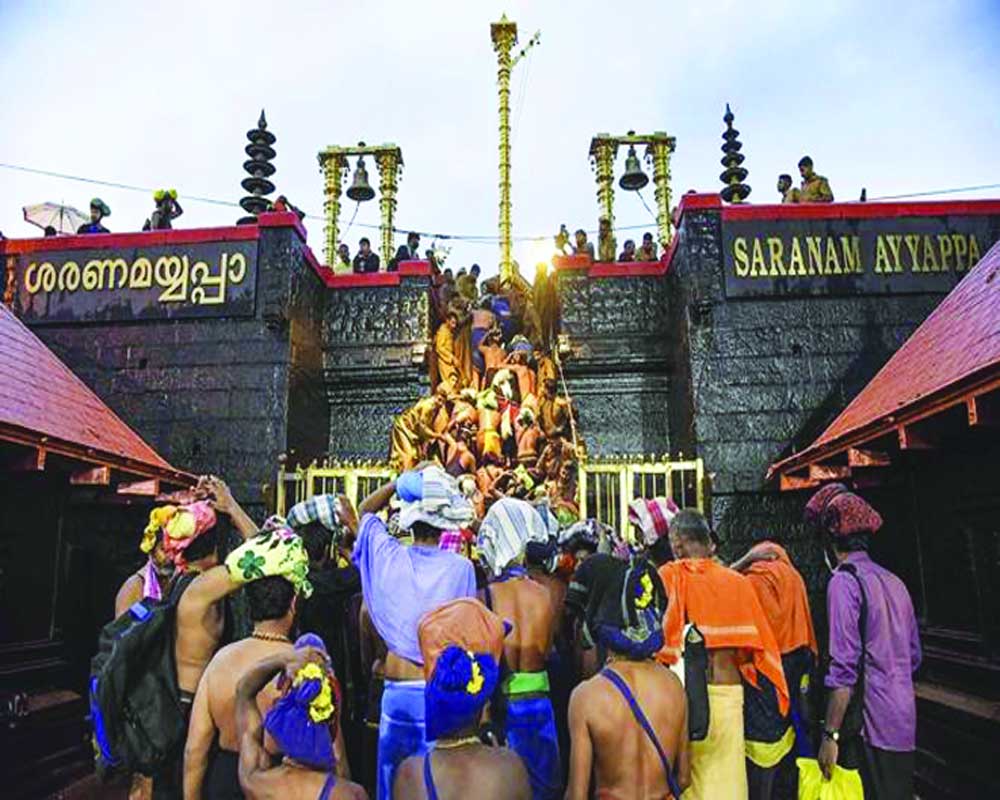By referring its order that allows women entry into the shrine to a larger Bench, SC is buying time, not giving in
Faith over women’s rights? A regressive over a progressive society? Religion justifying patriarchy or not? The Supreme Court needs more time, investigations and a larger bench to give answers on who can pray at Sabarimala, knowing that its ruling will become a precedent for all time to come and should, therefore, be well-considered. That it will affect 50 per cent of the nation’s population, namely women, who could always interpret justice as hostage to a brute majoritarian force. Till then, its earlier order allowing women of reproductive age into the shrine holds. There were assumptions that the Supreme Court’s verdict on Ayodhya, which relied heavily on the faith of believers and their continued practice of it, would influence it to review its own order. Simply because the patriarchal servitors of the house of Lord Ayyappa, the celibate God, had codified belief that women of a certain age group would bring temptation to a sacred space, if not the lord himself. As if menstruation and procreation were sins rather than the law of the universe. With their early hold on interpreting religion, they appropriated primacy by unequal means and solidified it as an ordained custom. They monopolised godliness when faith is a soul concern, irrespective of gender. They even equated the deity’s rights to that of Ram lalla’s, humanising the claims of the God-kings to be treated as private individuals in their own homes. Such has been the sanctity of this practice in the public domain that even Judge Indu Malhotra, during the earlier ruling, had wondered if the ban should be respected as the ritualistic right of a sect to keep to its customs as a secular allowance. The apex court doesn’t usually admit a review plea but given the confusion, it did so despite a 3:2 verdict, with justices Rohinton Nariman and DY Chandrachud against another relook. Though petitioners may claim an admission of oversight is implicit in this decision, there are layered takeaways. One, it is intended to defer another ruling of landmark proportions so soon after the Ayodhya verdict and control the fallout. Second, the top court has suggested widening the ambit of a woman’s devotional rights across religions, including the entry of women into mosques and Parsi shrines and the practice of female genital mutilation in the Dawoodi Bohra community. This could work both ways. For one, the localised appeal by a sect could be circumvented and made a subset of a larger ruling on democratic rights of women across religions. Or the Hindu sect could be treated at par with the other groups with a right to practise their socially sanctioned faith and attendant rituals. Last but not the least, the deferment helps most mainstream political parties, which do not want to deal with the ramifications before the Kerala elections in 2021. For the BJP, which has thrown its weight behind a review of the order allowing women inside the shrine, its stance has so far not yielded results, the party failing to win either a seat or increase its voteshare during the Lok Sabha elections. The Congress, in fact, has gained for endorsing the same line, that the hill shrine be entitled to its own traditions. So the court’s need to study the objections raised is a reprieve for all parties concerned.
Yet it raises a vital question. Why do we need the highest judicial authority of the land to lay down the code of societal evolution and dynamism when we should be reforming practices and executing them ourselves? Why are we still hesitant to acknowledge that we need to look at women as they are without being referenced by the patriarchal gaze, be it social or religious. Lord Ayyappa himself as a fountainhead of divinity would not have discriminated between his people. The Hindu pantheon has always prided the sacredness of both the masculine and feminine as essential attributes of spiritual enlightenment and has made women the originator of shakti. Our early Vedic texts are replete with examples of women scholars and priests. Believers maintain that Lord Ayyappa had sworn not to marry till his earthly mission was fulfilled and women devotees who understand empathise with the woman who still waits for him. But Ayyappa is also the most democratic god there is. Devotees dress uniformly in black, symbolising a renunciation of worldly pleasures and donning a garb of equality beyond caste and other social hierarchies. A Dalit can lead the prayers if he is the group leader and a Brahmin follower must touch his feet, too. Nowhere in Hindu rituals is such liberalism on display. So lord Ayyappa himself would not turn away the genuine seeker, be it a woman or man. When will we understand this?
Courtesy: The Pioneer








 OpinionExpress.In
OpinionExpress.In















Comments (0)